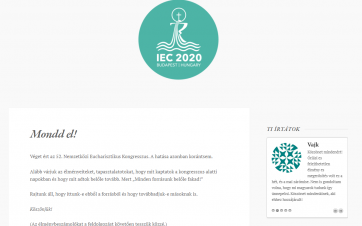
222 years – Saint Joseph Church

Having been liberated from the Ottoman rule in 1686, the area called Alsó-Külváros (Lower suburb), later on Pacsirtamező-Külváros (Lark’s meadow suburb) consisted mainly of arable lands and gardens. From 1720 onward, at first a considerable number of Germans, then Slovaks settled in, however Czech, Moravian, Polish, Romanian and Ruthenian families were looking for new homes in this territory. People needed sacral places as well, thus they built a Calvary and a belfry.
Large community’s small church
An independent parish was established in 1777. The first church was set up of wood, with a capacity of 380 only, therefore the local citizens turned to Emperor Joseph II asking for his permission to build a larger decorative church, named after Saint Joseph as the patron of the church, and also as a sign of respect for Emperor Joseph.
Racing speed
Construction began in 1788 upon the design of architect József Tallher, however, very soon it became clear that the ground was unsuitable to complete such a huge structure. It was Prince Primate József Batthyány who took care of and obtained the permission to set up the new church on the site of the former belfry. Work began in 1797. The simplified construction works proceeded in racing speed, thus no wonder that without waiting for the completion of the façade and the tower Mihály Pfingstl Parish priest celebrated a Holy Mass in the new church already at the end of 1799.

The good job and the time
Goes without saying that the over hurried work took its revenge. A few weeks after the handover, the choir loft collapsed along with the organ, and ruptures in the vault were recognised at the on-site inspection. Finally the church completion started in 1810, by this time with a design for two towers. This phase ended in 1814, but the towers were sealed with a pyramid roof instead of a copper helmet.
Three decades of waiting
The simple main altar was transformed into a decorative altar. Fundraising was going on from 1801 onward to cover the expenses, however significant donations arrived after 1825 only. The construction of the main altar started in 1835 upon the design of architect József Hild, world famous for his neoclassical architecture buildings. The altar was blessed in 1837 the day after Christmas. Only a year passed, and the Great Flood of Pest hit the city.
The devastation of the flood
The Great Flood of Pest in 1838 did not give pardon to the church either. Unfortunately the size of devastation is impossible to estimate by now, nevertheless, as to the inventory prepared in 1844, the damage may have been significant. The side altars of Saint Anthony of Padua, Our Lady of Perpetual Help and the fishing guild were so badly damaged that they had to be demolished. The first significant renovation was carried out after 1850, also with the guidance of architect József Hild.
Melted bells
Total reconstruction was executed following the Austro-Hungarian Compromise of 1867, and upon the new design of 1889 the church got a neo-baroque, neo-renaissance style. Three of the five bells of the tower were melted in during the 1st World War, however, due to a cooperation, these have been replaced by 1925.

1938. Gorgeous renewal
For the 1938 Eucharistic Congress further renovation works were completed. Restored frescoes, repainted ornamentals, new gildings on the statues and the side altars, on top of all a renovated pulpit characterized the result. During World War II the front line itself literally marched through the church, thus was used by the Soviet army as accommodation, kitchen and even toilets, and not to mention its total despoliation by the army.
Forced into silence
In 1983 Robert Schütz, popularly known as Brother Roger, the founder of the Taizé Community attended a silent Adoration in the church. It was silent in every sense, since the communist regime approved Brother Roger’s entry permit on condition that he would not speak in public, even more, no Taizé songs could be heard. In 1986 Saint Teresa of Calcutta was the guest of the church.
The new beginning
On the verge of the regime change the community life has got a swing. The reorganisation of the female monastic communities began here with the help of the Society of Social Brothers. Catechist teachers started their Biblical classes in municipal schools and kindergartens as early as 1990. Charity activities were reorganized and the swing has not stopped decades later either.
Spiritual centre
The church is considered as the spiritual centre of the Slovak population in Budapest. The district (Józsefváros – Joseph’s city) regularly hosted homilies in Slovak language in the second half of the 19th century, and as to a guide book of the 20th century turn, on Sundays and Holidays Slovak Homily was held at 18:30, followed by the Slovak Holy Mass at 19:00. In addition, the Saint Joseph church hosted monthly Romanian Holy Mass for the spiritual care of the Csángós staying in Budapest.
IEC: Holy Mass in Slovak language
Also at the turn of the 20th century the Budapeštiansky katolicky delnícky kruh (Budapest Catholic Working Group), a Christian socialist working group was formed under the leadership of Endre Sándorfi parish priest. Father Sándorfi’s aim was to provide the members with religious and moral guidance and education. Thus it is obvious that in the frame of the day of Parishes of the International Eucharistic Congress, on the 8th September S.E.R. Bernard Bober, Metropolitan Archbishop of Košice, Slovakia is going to celebrate a Holy Mass in Slovak.
Within the same family
The Metropolitan Archbishop of Košice strives for a lively, cross-border dialogue. The relic of Blessed Anna Kolesárová was placed on the IEC’s Mission Cross – the symbol of the International Eucharistic Congress – by Archbishop Bernard Bober. As a commemoration of the Martyrs of Košice, their relics were also embedded into the Mission Cross on the 400th anniversary of their death. The Archbishop underlined: “None of these three Saint Martyrs of Košice were of Slovakian origin. All three of them arrived from various cultural backgrounds: Mark Krizin was born in the area of the current Croatia, Melchior Grodziecki was from Poland, while Stephen Pongracz was of Transylvanian origin. They were martyred in Košice, thus becoming Košicen people. Their shared faith made them brothers, proving the supranational nature of the Catholic Church. The Church that gathers each and every of the baptized ones into one single great family, regardless of their race or nationality.”
|
The Calvary This history of the building –that once stood on the current Kálvária (Calvary) Square- is rather strange. A wealthy woman, Maria Anna Schwartz, killed her husband in the heat of a debate, for which she was life sentenced. The woman asked to serve her sentence in a Pauline monastery, and as a penance she decided to use her wealth for building a chapel. Construction works took place between 1746 and 1749, while the Calvary Chapel was consecrated in 1795. At the end of the 19th century, the time when Budapest was developing into a world city, upon the initiative of architect Alajos Stróbl, in the course of the town planning the Chapel was moved stone by stone to its current location in Terézváros, Budapest, to the today’s campus –called Epreskert (Strawberry Garden) - of the Hungarian University of Fine Arts, at Bajza street 41. |
Photo and source: http://www.jozsefvaros.plebania.hu/, esztergomi-ersekseg.hu










